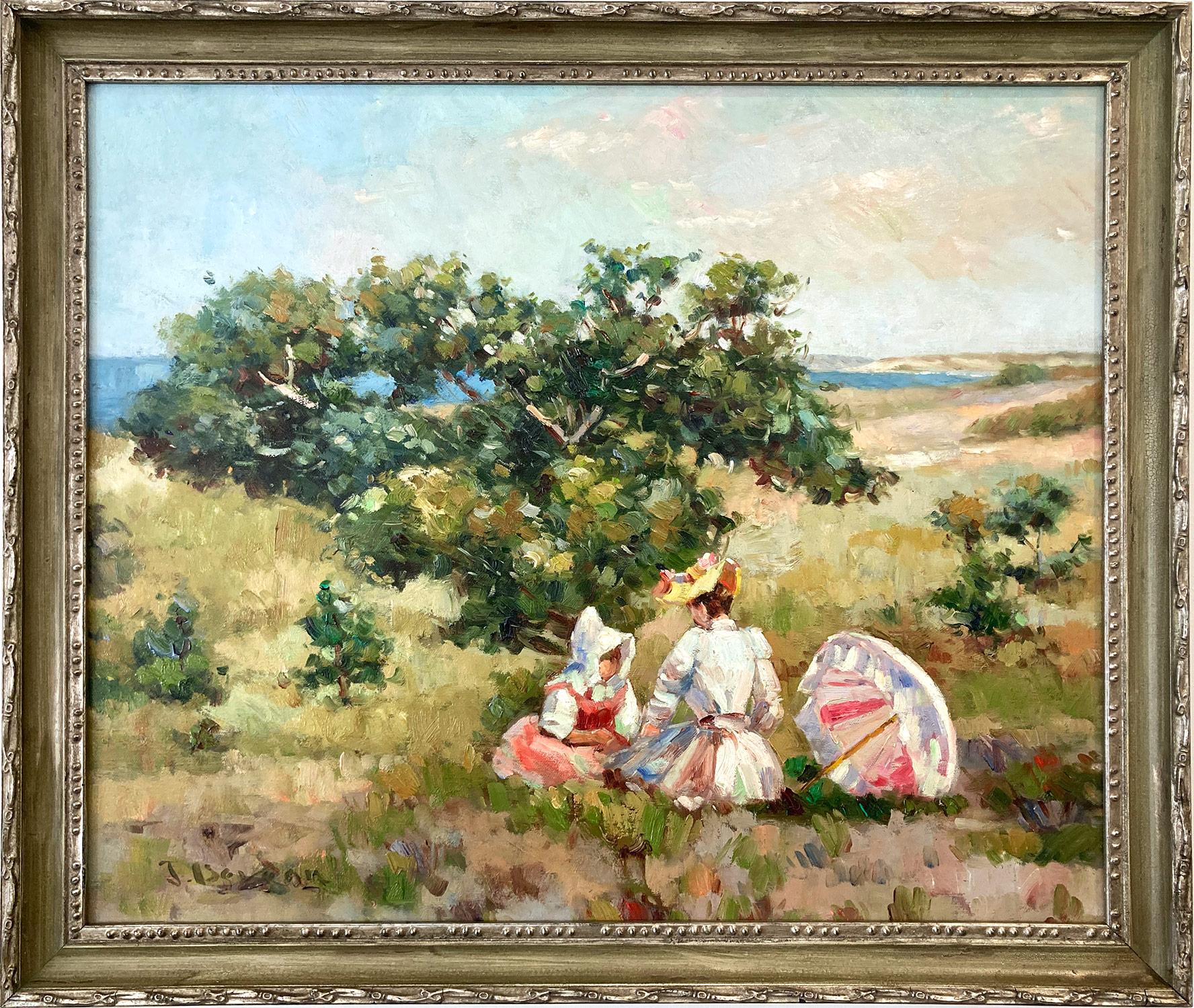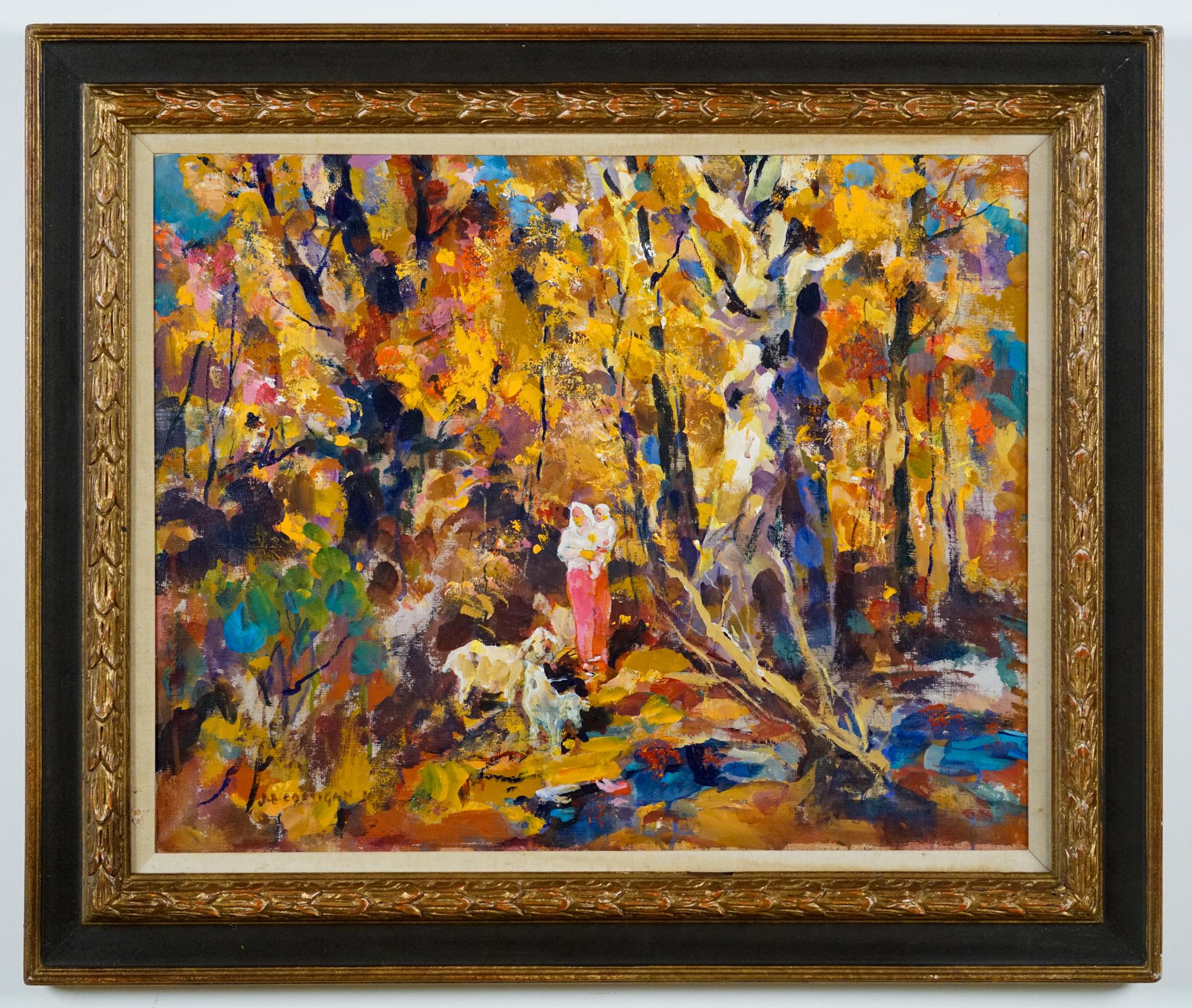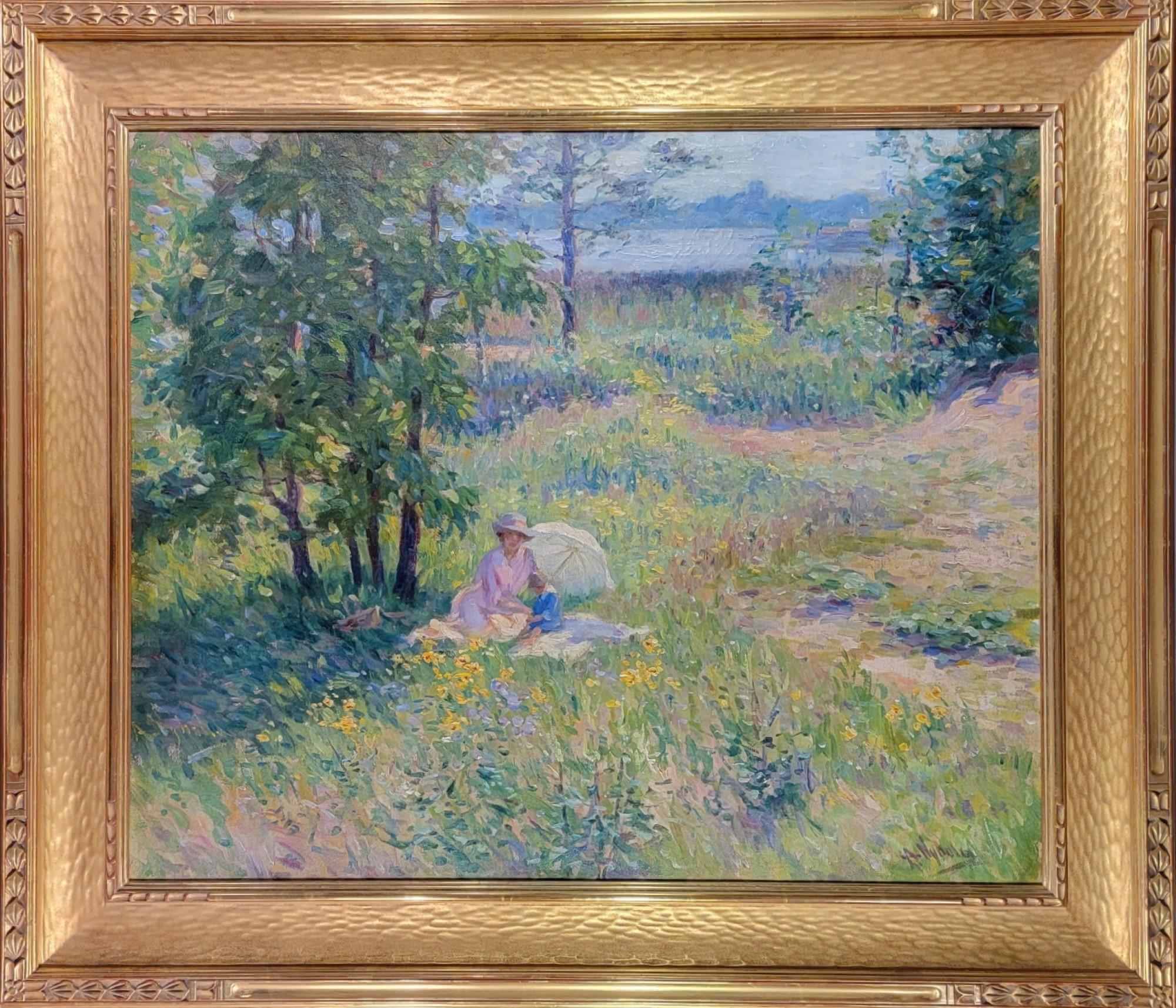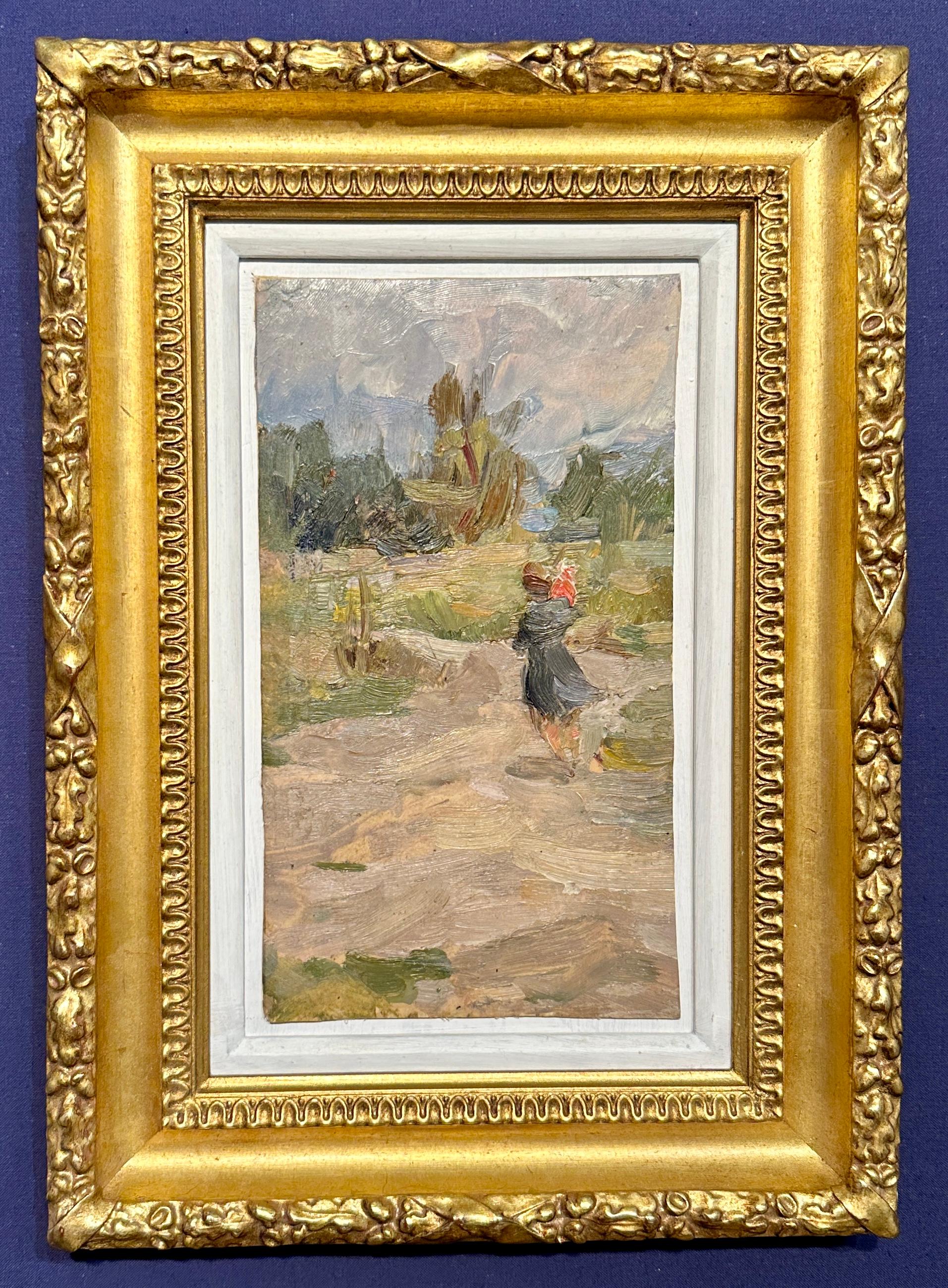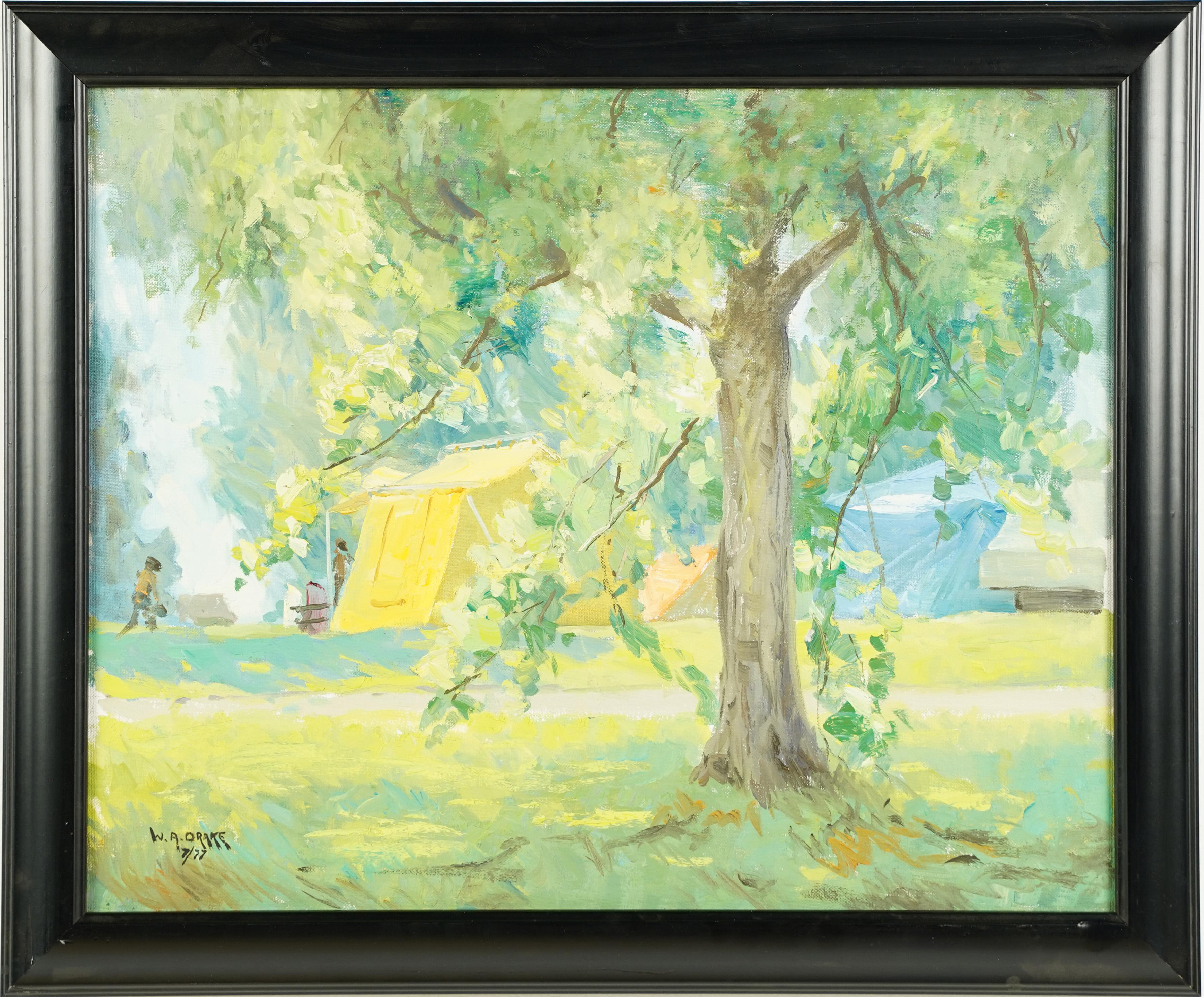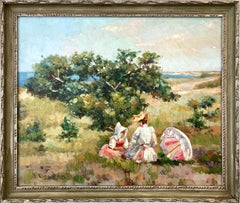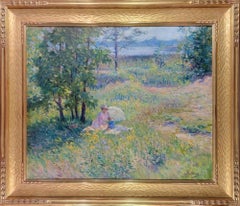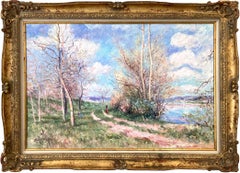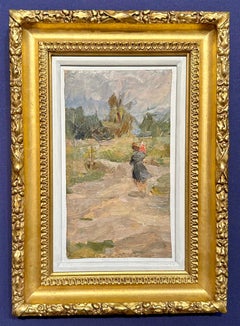Items Similar to Mother & Child in a Landscape, framed in an important Carrig Rohane frame
Want more images or videos?
Request additional images or videos from the seller
1 of 8
André GissonMother & Child in a Landscape, framed in an important Carrig Rohane frame
$9,600
£7,123.57
€8,297.99
CA$13,363.27
A$14,881.21
CHF 7,744.85
MX$183,483.48
NOK 98,636.53
SEK 92,708.78
DKK 61,913.27
Shipping
Retrieving quote...The 1stDibs Promise:
Authenticity Guarantee,
Money-Back Guarantee,
24-Hour Cancellation
About the Item
Andre Gisson
American, 1921-2003
Mother & Child in a Landscape
Oil on canvas
24 by 36 in. W/frame 32 by 44 in.
Signed lower left
Framed in an important Carrig Rohane frame
Impressionist painter, Andre Gisson, was born in New York in 1929,and studied art at the Pratt Institute. After graduation, he joined the United States Armed Services and resumed his career in art upon his return to New York. Gisson continued his studies in Europe, where he came under the influence of the great French impressionists.
Throughout his career, Gisson has developed and refined the style and technique of impressionism, with its small broken brushwork and soft, vibrant colors. A versatile artist, he is equally adept at painting landscapes, coastal scenes, still lifes, and portraits. His landscapes depict the French countryside, where he paints every summer, and the region around Lake Mahopac in upstate New York, where he lived for many years.
Gisson has exhibited in leading art galleries throughout the country, from New York to Texas, and from Philadelphia to California. Newman Galleries has represented his work since 1957, and his paintings are found in many prominent collections in the Philadelphia area.
Several of Gisson’s paintings have been published and distributed internationally.
Provenance:
Private Collection New York
Alexander Avenard Collection
Le Trianon Fine Art & Antiques
Art G258
- Creator:André Gisson (1929-2003, American)
- Dimensions:Height: 32 in (81.28 cm)Width: 44 in (111.76 cm)Depth: 2 in (5.08 cm)
- Medium:
- Movement & Style:
- Period:
- Condition:
- Gallery Location:Sheffield, MA
- Reference Number:Seller: Art G2581stDibs: LU70037849952
André Gisson
André Gisson was born 'Anders Gittelson' in 1921 in Brooklyn, New York. A widely-collected American Impressionist painter, he is known for landscape, still life, portrait and figure paintings. In order to be seen as belonging to the French Impressionist movement, he claimed to be a Frenchman born in 1910, and adopted the artist name 'André Gisson'. He lived in New York, Westport, Connecticut and France for much of his life, and traveled widely. He studied at the prestigious Pratt Institute in New York. After graduation, he joined the United States Army and become a captain during World War II. Gisson continued his studies in Europe, where he came under the influence of the great French impressionists. Upon his return to New York, he adapted the style and technique of impressionism and used small, broken brushwork and soft and vibrant colors. Gisson's landscapes and beach scenes depict the French countryside, where he painted every summer, and the region around Lake Mahopac in upstate New York, where he lived for many years. Gisson's still life compositions show a Japanese influence in his work; whereas the French influence is more pronounced in his landscapes and figures. Several of Gisson’s paintings have been published and distributed internationally. His works have been exhibited in leading art galleries throughout the country for over four decades, as a solo show extended from New York, Washington, Philadelphia, Texas and California, also overseas locations in London, Paris and Tokyo. His work are part of the collections of the Smithsonian Institution and the Triton Museum of Art, in North Carolina. Among his private collectors were President Lyndon B. Johnson and W. Somerset Maugham. Gisson died in 2003 in Atlanta, Georgia. He was listed in The Artist's Yearbook (p. 332, 2000), Artists in the Southwest Art (p. 64, 1993) and Who Was Who in American Art (p. 1296, 1999).
About the Seller
4.0
Vetted Professional Seller
Every seller passes strict standards for authenticity and reliability
1stDibs seller since 2017
53 sales on 1stDibs
Typical response time: 10 hours
- ShippingRetrieving quote...Shipping from: Sheffield, MA
- Return Policy
Authenticity Guarantee
In the unlikely event there’s an issue with an item’s authenticity, contact us within 1 year for a full refund. DetailsMoney-Back Guarantee
If your item is not as described, is damaged in transit, or does not arrive, contact us within 7 days for a full refund. Details24-Hour Cancellation
You have a 24-hour grace period in which to reconsider your purchase, with no questions asked.Vetted Professional Sellers
Our world-class sellers must adhere to strict standards for service and quality, maintaining the integrity of our listings.Price-Match Guarantee
If you find that a seller listed the same item for a lower price elsewhere, we’ll match it.Trusted Global Delivery
Our best-in-class carrier network provides specialized shipping options worldwide, including custom delivery.More From This Seller
View AllWoman and Child
By John Edward Costigan
Located in Sheffield, MA
John Edward Costigan, N.A.
American, 1888-1972
Woman and Child
Oil on canvas
Signed ‘J.E. Costigan N.A.’ lower left
24 by 30 in. W/frame 32 by 38 in.
John Costigan was born of Irish-American parents in Providence, Rhode Island, February 29, 1888. He was a cousin of the noted American showman, George M. Cohan, whose parents brought the young Costigan to New York City and was instrumental in starting him on a career in the visual arts. They were less successful in encouraging him to pursue formal studies at the Art Students League (where, however, he later taught) than in exposing him to the commercial art world through the job they had gotten him with the New York lithographing firm that made their theatrical posters.
At the H. C. Miner Lithographing Company, Costigan worked his way up from his entry job as a pressroom helper, through various apprenticeships, to the position of sketch artist. In the latter capacity he was an uncredited designer of posters for the Ziegfeld Follies and for numerous silent films. Meanwhile, he had supplemented his very meager formal studies in the fine arts with a self-teaching discipline that led to his first professional recognition in 1920 with the receipt of prizes for an oil painting and watercolor in separate New York exhibitions.
A year earlier, Costigan had wed professional model Ida Blessin, with whom he established residence and began raising a family in the sleepy little rural New York hamlet of Orangeburg, the setting for the many idyllic farm landscapes and wood interiors with which he was to become identified in a career that would span half a century.
John Costigan’s first national recognition came in 1922 with his winning of the coveted Peterson Purchase prize of the Art Institute of Chicago for an oil on canvas, “Sheep at the Brook.” It marked the start of an unbroken winning streak that would gain him at least one important prize per year for the remainder of the decade. The nation’s art journalists and critics began to take notice, making him the recurring subject of newspaper features and magazine articles. The eminent author and critic Edgar Holger Cahill was just a fledgling reporter when he wrote his first feature, “John Costigan Carries the Flame,” for Shadowland Magazine in 1922. Costigan had his first one-man show of paintings at the Rehn Gallery on New York’s 5th Avenue in November, 1924, to be followed less than three years later by another at the Art Institute of Chicago. In addition, Costigan’s work has been—and continues to be included, side-by-side with that of some of America’s most high-profile artists, in museum and gallery exhibitions throughout the country. His renown had peaked in the early 1930s, by which time his work had been honored with nearly every major award then being bestowed in the fine arts and had been acquired for the permanent collections of several prestigious American museums, including New York’s Metropolitan (which only recently, in 1997, deaccessioned his “Wood Interior,” acquired in 1934).
Although Costigan’s celebrity had ebbed by the late 1930s, the Smithsonian Institution saw fit in 1937 to host an exhibition exclusively of his etchings. And, in 1941, the Corcoran Gallery (also Washington, D.C.) similarly honored him for his watercolors. (Another Washington institution, the Library of Congress, today includes 22 Costigan etchings and lithographs in its permanent print collection.)
During World War II, Costigan returned briefly to illustrating, mainly for Bluebook, a men’s pulp adventure magazine. A gradual revival of interest in his more serious work began at the end of the war, culminating in 1968 with the mounting of a 50-year Costigan retrospective at the Paine Art Center and Arboretum in Oshkosh, Wisconsin. Oils, watercolors and prints were borrowed from museums and private collections throughout the country, and the exhibition was subsequently toured nationally by the Smithsonian Institution.
John Costigan died of pneumonia in Nyack, NY, August 5, 1972, just months after receiving his final prestigious award —the Benjamin West Clinedinst Medal of the Artist’s Fellowship, Inc., presented in general recognition of his “...achievement of exceptional artistic merit...” in the various media he had mastered in the course of his career.
This painting depicts one of the artist's favorite themes --the farm family bathing...
Category
1940s Post-Impressionist Landscape Paintings
Materials
Oil
French Countryside
Located in Sheffield, MA
Charles Charlay-Pompon
French, 1854-1914
French Countryside
Oil on canvas
Signed lower right
11 by 21 in. w/frame 16 ½ by 26 ½ in.
Charles Charl...
Category
1880s Impressionist Landscape Paintings
Materials
Oil
Figures in a Landscape
By Lucien Adrion
Located in Sheffield, MA
Lucien Adrion
French, 1889-1953
Figures in a Landscape
Oil on canvas
22 by 33 in, w/ frame 29 ½ by 39 ¾ in
Signed lower left
Lucien Adrion was born in Strasbourg, France in 1889 an...
Category
Early 20th Century Impressionist Landscape Paintings
Materials
Oil
Coastal Scene
By Walter Griffin
Located in Sheffield, MA
Walter Parsons Shaw Griffin
American, 1861-1935
Coastal Scene
Oil on canvas
27 ¼ by 32 in, w/ frame 39 by 44 in
Signed lower left
Born in Portland, Maine on 14 January 1861, the so...
Category
Late 20th Century Impressionist Landscape Paintings
Materials
Oil
$10,200
Spring Landscape
By George Laurence Nelson
Located in Sheffield, MA
George Laurence Nelson
American, 1887-1978
Spring Landscape
Oil on canvas
20 ⅛ by 24 ⅛ in, w/ frame 28 by 32 in
Signed and dated 1912 lower right
George Laurence Nelson was born in...
Category
1910s Impressionist Landscape Paintings
Materials
Oil
The Valley, York Maine
Located in Sheffield, MA
Alice R. Comins
American, 1861-1943
The Valley, York Maine
Oil on canvas
20 by 26 in. W/frame 27 by 33 in.
Signed lower right and dated 1913 & titled on r...
Category
1910s American Impressionist Landscape Paintings
Materials
Oil
You May Also Like
"Mother and Child in the Garden by the Coast" Impressionist Oil Painting Framed
Located in New York, NY
A masterful oil painting depicting a view of a coastal view with a Mother and Child seated by the flowers in the grass with a camisole umbrella. This piece is an excellent example of...
Category
Early 20th Century Post-Impressionist Landscape Paintings
Materials
Canvas, Oil
Landscape Painting by Arvid Nyholm, Impressionist, Swedish American, Chicago
Located in Grand Rapids, MI
Arvid Frederick Nyholm (Swedish-American, 1866-1937)
Signed: A Nyholm (Lower, Right and Lower, Left)
" Mother and Child in a Landscape ", circa 1910-1920
Oil on Canvas
25" x 30"...
Category
1910s Impressionist Landscape Paintings
Materials
Canvas, Oil
"British Countryside Landscape" British Impressionist Oil Painting Framed
By John Clymer
Located in New York, NY
A masterful oil painting depicting a colorful British country side with a couple strolling in the distance along a beautiful pathway. As an Impressionist painter, Clymer was known fo...
Category
Early 20th Century American Impressionist Landscape Paintings
Materials
Canvas, Oil
20th Century Oil painting, an Impressionist landscape with figures
By Ken Moroney
Located in Woodbury, CT
20th Century Oil painting of an Impressionist scene of of an Impressionist landscape.
Moroney was born on the 14th of February 1949 in South London. Of Anglo Irish parentage, his f...
Category
1980s Impressionist Landscape Paintings
Materials
Canvas, Oil, Wood Panel
Vintage Signed Canadian Impressionist Landscape Framed Luminous Oil Painting
Located in Buffalo, NY
Antique Canadian impressionist landscape signed oil painting. Oil on board. Signed. Framed. Image size, 20L x 16H.
Category
1950s Impressionist Landscape Paintings
Materials
Canvas, Oil
$636 Sale Price
20% Off
Mother & Daughter by Lake Fine Impressionist Oil Painting on Canvas framed
Located in Cirencester, Gloucestershire
Rest as the World Goes By
Juan Soler, Spanish b.1951
signed oil painting on canvas, framed
framed: 20 x 22 inches
canvas: 13 x 16 inches
provenance: private collection, London
condi...
Category
20th Century Impressionist Figurative Paintings
Materials
Oil
$2,208 Sale Price
30% Off
More Ways To Browse
Carrig Rohane Frame
Carrig Rohane
Dali Franklin
Dali Horseman
Dali Melted Clock
Dali Men Who Eat
Dali Owl
Dali Pater Noster
Dali Pegasus
Dali Pig And Pepper
Dali Signs Of The Zodiac
Dali Sodomites
Dali St George And The Dragon
Dali St John Of The Cross
Dali Tarot Card
Dali Tienta
Dali Virgil Last Words
Dalinean Horse
